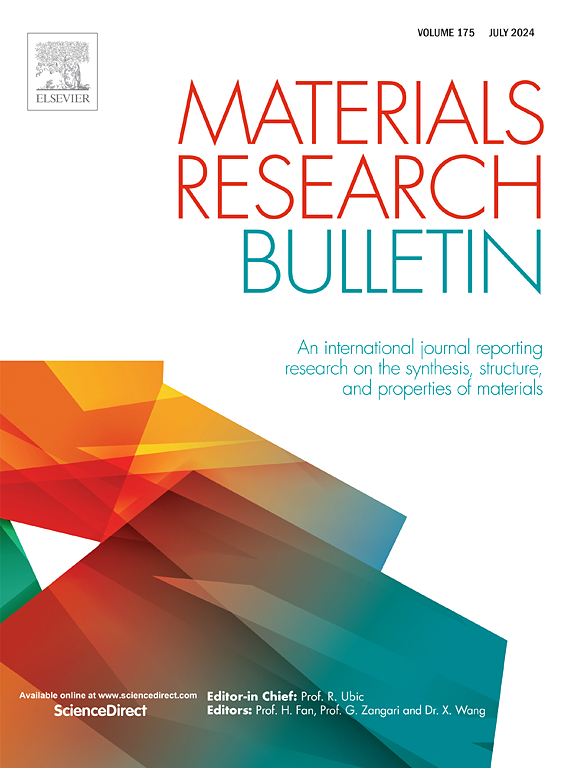Enhanced photocatalytic oxidation through optimized CuFe2O4 distribution in MIL-125(Ti) heterostructures
IF 5.3
3区 材料科学
Q2 MATERIALS SCIENCE, MULTIDISCIPLINARY
引用次数: 0
Abstract
A novel ternary p-n heterojunction CuFe2O4/CNT/MIL-125(Ti) composite (CCM) was fabricated to enhance photocatalytic oxidation and enable magnetic recyclability for organic pollutants degradation. Pre-integration of CuFe2O4/CNT before MIL-125(Ti) assembly prevented magnetic nanoparticle aggregation and established electron transport bridges. Optimized CCMs (CCM-5, CCM-10, and CCM-20) exhibited bandgaps narrowed to 3.65, 3.58, and 3.47 eV, respectively, with increased photocurrent and reduced impedance, enhancing visible-light absorption and suppressing charge recombination. CCM-10 with proper CuFe2O4/CNT proportion achieved over 98.0 % Rhodamine (RhB) and 95.9 % Tetracycline Hydrochloride (TCH) removal within 60 min, with the reaction rate constant 86.7 % and 206.8 % higher than MIL-125(Ti), respectively. The composite can be easily separated magnetically and reused, showing only a 12.3 % decline in activity after five cycles of RhB degradation. The photocatalytic degradation mechanism was also explored, with superoxide anion radicals identified as the main contributors. This work highlights a rational interface-engineering approach to constructing a magnetically recoverable MIL-125(Ti)-based photocatalyst.

通过优化MIL-125(Ti)异质结构中CuFe2O4的分布增强光催化氧化
制备了一种新型的三元p-n异质结CuFe2O4/CNT/MIL-125(Ti)复合材料(CCM),以增强光催化氧化和实现磁可回收性,用于有机污染物的降解。在MIL-125(Ti)组装之前,CuFe2O4/CNT的预集成阻止了磁性纳米颗粒聚集并建立了电子传递桥。优化后的ccm (CCM-5、CCM-10和CCM-20)带隙分别缩小至3.65、3.58和3.47 eV,光电流增加,阻抗降低,增强了可见光吸收,抑制了电荷复合。在适当的CuFe2O4/CNT比例下,CCM-10在60 min内对罗丹明(RhB)和盐酸四环素(TCH)的去除率分别达到98.0%和95.9%,反应速率分别比MIL-125(Ti)高86.7%和206.8%。该复合材料可以很容易地磁分离和重复使用,在RhB降解5次循环后,其活性仅下降12.3%。探讨了光催化降解机理,确定了超氧阴离子自由基是光催化降解的主要因素。这项工作强调了一种合理的界面工程方法来构建磁可回收MIL-125(Ti)基光催化剂。
本文章由计算机程序翻译,如有差异,请以英文原文为准。
求助全文
约1分钟内获得全文
求助全文
来源期刊

Materials Research Bulletin
工程技术-材料科学:综合
CiteScore
9.80
自引率
5.60%
发文量
372
审稿时长
42 days
期刊介绍:
Materials Research Bulletin is an international journal reporting high-impact research on processing-structure-property relationships in functional materials and nanomaterials with interesting electronic, magnetic, optical, thermal, mechanical or catalytic properties. Papers purely on thermodynamics or theoretical calculations (e.g., density functional theory) do not fall within the scope of the journal unless they also demonstrate a clear link to physical properties. Topics covered include functional materials (e.g., dielectrics, pyroelectrics, piezoelectrics, ferroelectrics, relaxors, thermoelectrics, etc.); electrochemistry and solid-state ionics (e.g., photovoltaics, batteries, sensors, and fuel cells); nanomaterials, graphene, and nanocomposites; luminescence and photocatalysis; crystal-structure and defect-structure analysis; novel electronics; non-crystalline solids; flexible electronics; protein-material interactions; and polymeric ion-exchange membranes.
 求助内容:
求助内容: 应助结果提醒方式:
应助结果提醒方式:


